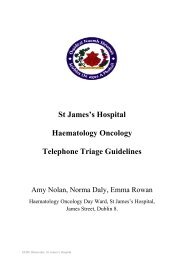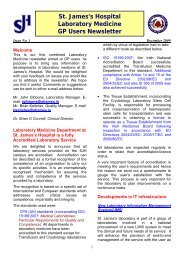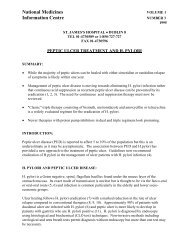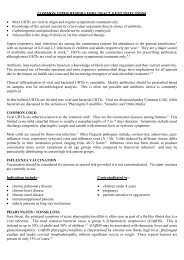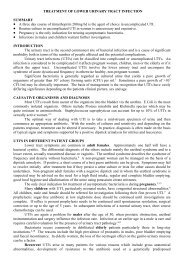ACUTE EXACERBATION <strong>OF</strong> CHRONIC BRONCHITISAcute exacerbation of chronic bronchitis (AECB) has a multifactorial aetiology including a viral,bacterial, allergic or environmental pollutant as possible causes. Antibiotics are commonly prescribedduring AECB but evidence that they appreciably alter outcome is lacking 3 . As one quarter of patientsreturn to their GP's with incomplete recovery, antibiotics may only benefit certain sub-groups that are notyet well characterised 4 . However studies have shown significant benefit from antibiotics compared withplacebo in patients judged to have moderate to severe COAD on the basis of increased dyspnoea, sputumproduction and sputum purulence. In the same study no benefit from antibiotics was demonstrated formilder exacerbations involving only one of these symptoms 5 .Ideally antibiotic treatment should be based on sputum culture but in practice empirical treatment isnecessary. The choice of antibiotics should cover the most common organisms which includeHaemophilus influenzae, Streptococcus pneumoniae and Moraxella catarrhalis.COMMUNITY ACQUIRED PNEUMONIA (CAP)Most cases of CAP can be treated in the community but there is increased mortality associated withrespiratory rate greater than 30 per minute, age over 60 years, confusion, diastolic blood pressure lessthan 60mmHg, multilobar involvement and atrial fibrillation 1 . Antibiotic therapy should be commencedimmediately without waiting for culture results and should always cover Streptococcus pneumoniae, themost common cause of CAP. Haemophilus influenzae and Moraxella catarrhalis are the next mostprevalent.Infection with Mycoplasma pneumoniae occurs in epidemics of 4-5 year cycles, occurs commonly inchildren and young adults and if suspected should be treated with erythromycin for 10-14 days 6 .Staphylococcus aureus should be considered during epidemics of influenza and should be treated withflucloxacillin if suspected.<strong>TREATMENT</strong> <strong>OF</strong> LRTIThe penicillins are still suitable for the empiric treatment of CAP and amoxycillin 250-500mg tid (orampicillin 250-500mg qid) for seven days is usually sufficient. Clinically severe CAP may requireaternative antibiotic therapy. Some strains of Streptococcus pneumoniae have "intermediate resistance"to penicillin, but studies show that these resistant strains are sensitive to higher doses of penicillin 6,7,8 .Generally elderly patients with COAD tend to be colonised with Haemophilus influenzae and if theexacerbation is severe they should be given co-amoxyclav or the newer macrolides (e.g. clarithromycin,azithromycin) because these antibiotics have greater activity against Haemophilus influenzae. Inaddition these patients tend to reinfect with bacteria that already colonise their respiratory tract and soprevious sputum cultures may provide a clue to the possible cause. There are an increasing number ofbeta-lactamase producing strains of Haemophilus influenzae and Moraxella catarrhalis and so coamoxyclavis recommended in cases suspected of these organisms.The newer oral cephalosporins, cefaclor, cefixime and cefuroxime are all beta-lactamase stable and arealternatives to the penicillins, for beta-lactamase producing strains of Haemophilus influenzae andMoraxella catarrhalis. These cephalosporins are generally no more active than penicillin in penicillinsensitiveand penicillin-resistant Streptococcus pneumoniae. It has been suggested that cephalosporinsshould not be used to treat most community acquired infections because multiple resistant organisms areunusual and other drugs exist with narrower spectrum of activity 9 .The fluroquinolones, (ciprofloxacin and ofloxacin) have relatively poor activity againstStreptococcus pneumoniae which is a predominant LRTI pathogen, and so have no place as singleagents in blind treatment of LRTI. They are effective against Haemophilus influenzae and atypicalpathogens such as Mycoplasma pneumoniae. Co-trimoxazole, while effective against Streptococcus
pneumoniae and Haemophilus influenzae is associated with several undesirable adverse effects such asblood and generalised skin disorders. It should only be considered for the treatment of communityacquired LRTI when there is good bacteriological evidence of sensitivity to co-trimoxazole and a goodreason to prefer this combination to a single antibiotic 10 . Tetracycline can not be recommended for theroutine treatment of LRTI.RESISTANCE AND ANTIBIOTIC ASSOCIATED COLITISMicrobial resistance problems arise as antimicrobial therapy leads to alteration of normal body flora witha resultant increase in the number of resistant organisms. Many organisms are naturally resistant toantibiotics, but resistance may also be acquired. In addition beta-lactamase stable antibiotics, particularlythe third generation cephalosporins are more likely to lead to the emergence of resistant strains mainly inthe gram negative pathogen spectrum leading to fungal infections and antibiotic associated colitis 10,11 .Almost all antibacterial agents have been observed to induce diarrhoea in some patients which if severemay indicate pseudomembraneous colitis (PMC). Patients treated with cephalosporins, penicillinaseresistant or multiple antibiotic regimes are seen to be at higher risk of PMC. A patient with severediarrhoea during or within 4-6 weeks of antibiotic treatment should be suspected of antibiotic associatedcolitis 10,11 .IMPORTANT DRUG INTERACTIONSA number of the newer antimicrobials may inhibit liver drug metabolism:-• The anticoagulant effect of warfarin may be enhanced by the macrolides (e.g.erythromycin), ciprofloxacin, ofloxacin.• Theophylline levels may be increased by the macrolides and ciprofloxacin.• Hypoglycaemic effect of sulphonylurea is enhanced by ciprofloxacin, ofloxacin and cotrimoxazole.• Carbamazepine blood levels are elevated by macrolides.• Broad spectrum antibiotics may reduce the contraceptive efficacy of the combined oral contraceptivepill.SAFETY <strong>OF</strong> ANTIBIOTICS IN PREGNANCY• The aminopenicillins (amoxycillin and ampicillin) are generally regarded as safe to use duringpregnancy. There is no evidence of teratogenicity due to co-amoxyaclav (augmentin), although themanufacturer advises to avoid use unless essential.• The fluroquinolones (ciprofloxacin and ofloxacin) are contraindicated during pregnancy due to therisk of arthropathy in animal studies.• Cephalosporins are not thought to be harmful during pregnancy, yet all manufacturers advise cautionand to avoid unless neccessary.• The macrolides are not known to be harmful, but caution is advised so that they are used only whenthe benefit exceeds the risk.CONCLUSIONAs repeat consultations for acute respiratory symptoms are common, general practitioners are underconsiderable pressure to prescribe a wide variety of new antibacterial drugs as a potential solution to thisproblem. These treatments will have to be much more effective than current therapy in order to be costeffective and there is little evidence that they are clinically superior to penicillins in the majority ofpatients 13 .COST



